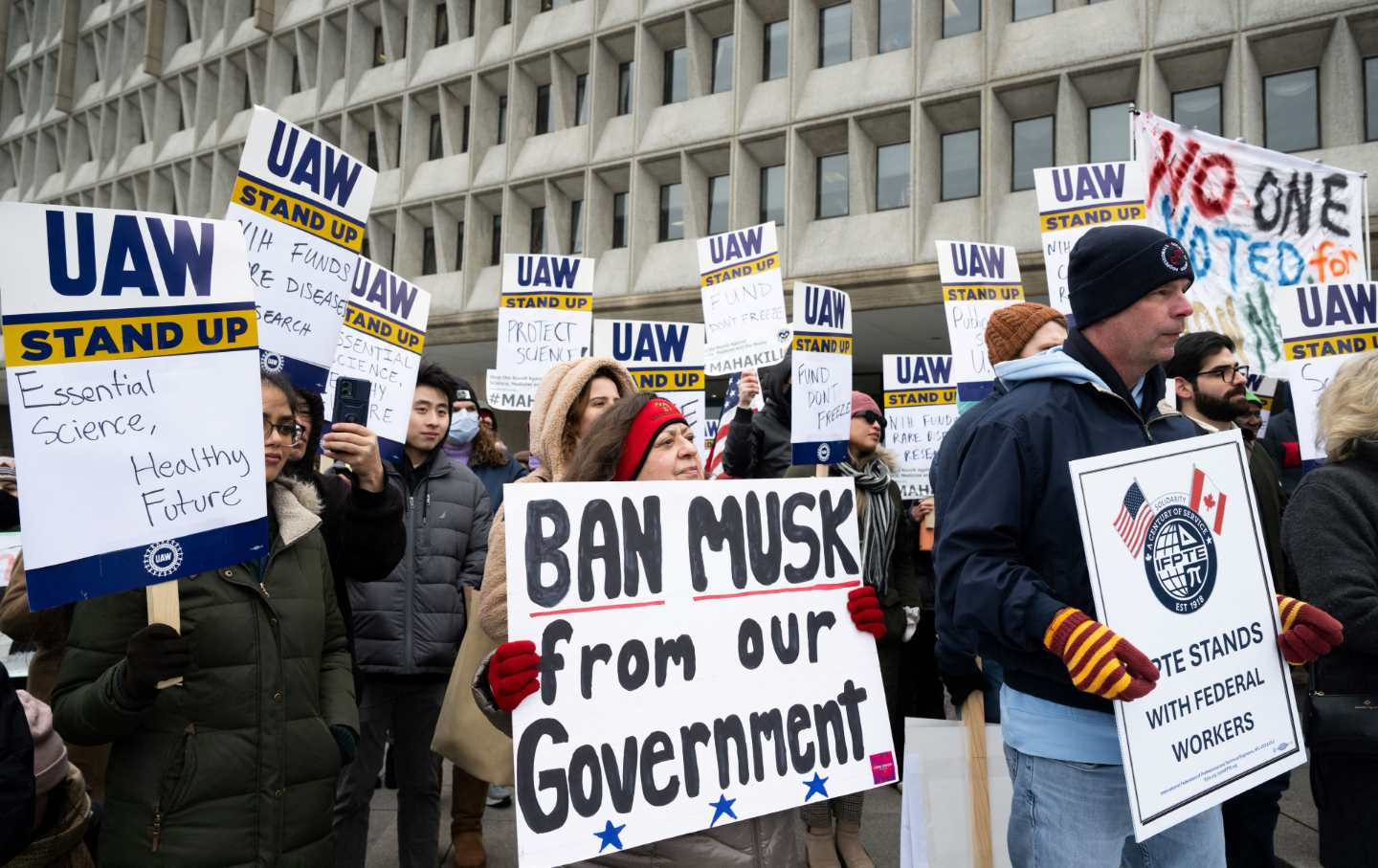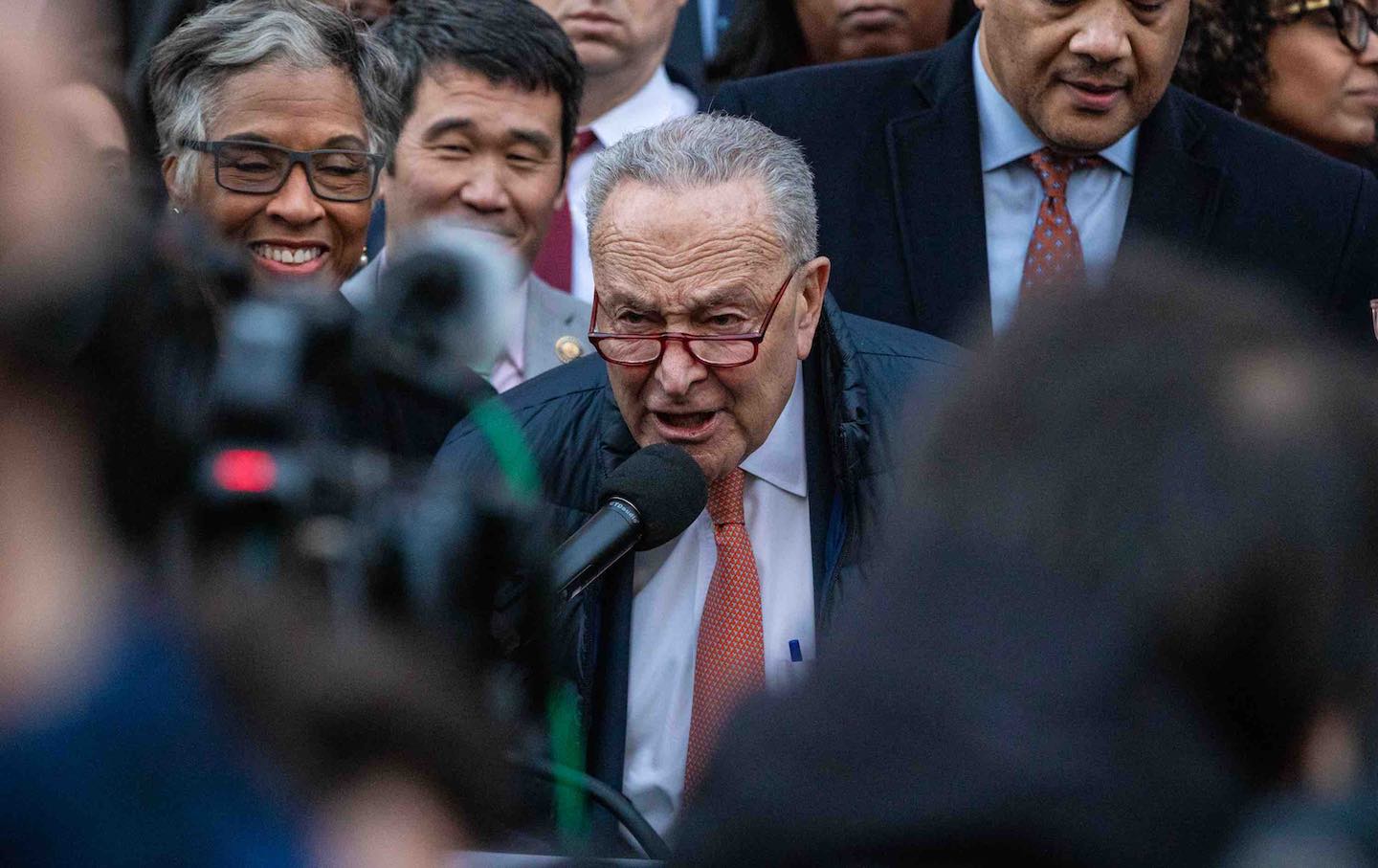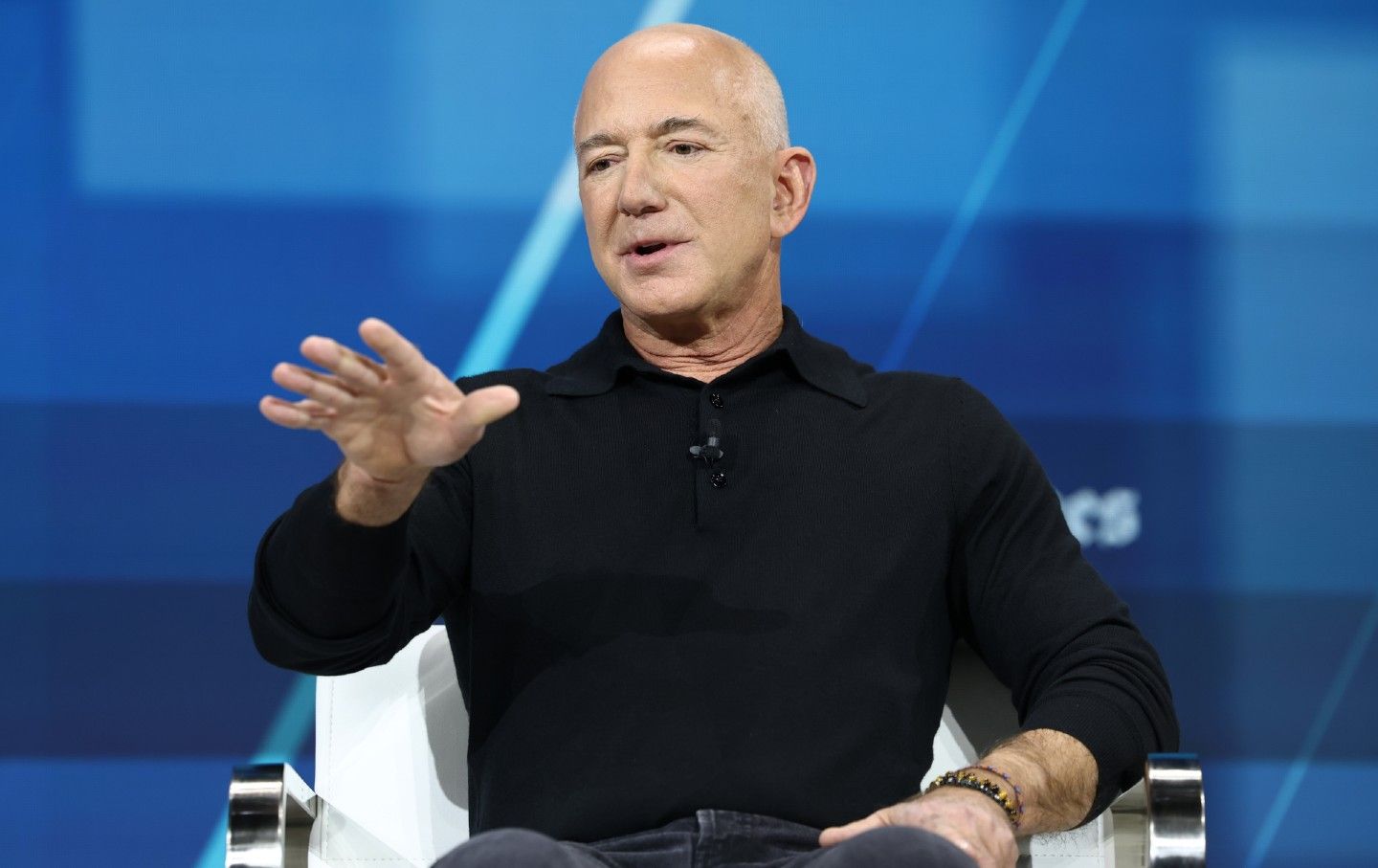The Problem With “Weird”
The Democrats’ repositioning as the party of “normalcy” undercuts its history of emancipatory social movements and participates in an antidemocratic ethos.

(Mark Ralston / AFP via Getty Images)
Governor Tim Walz catapulted to the vice-presidential nomination of the Democratic Party by mobilizing the power of a single word: “weird.” Referring to Donald Trump’s agenda for a second term, Walz asked the Democratic National Convention, “Is it weird?” He offered an unequivocal answer to a thunderous roar from the crowd: “Absolutely, absolutely!” The power of Walz’s invocation of MAGA weirdness is found in the enduring appeal of its opposite: normalcy. Walz’s vice-presidential bid to corner the market on normal Americana is part of a broader anti-MAGA normalcy strategy for Democrats. Observers of the DNC noted a variety of normalcy narratives, including a pronounced patriotism, an emphasis on family values, and the theme of neighborliness, all laying claim to the cultural authority of normalcy, long held by Republicans.
While this effusion of normalcy has been welcomed by many liberals, it presents a dilemma that should temper our enthusiasm for Walz’s quip. The promulgation of normalcy is incongruous with the Democrat’s most paramount aim: the defense of democracy. The democratization of American politics has advanced through emancipatory social movements that found it necessary to challenge the contours of normal politics. At its best, the Democratic Party has functioned as a coalitional force harnessing the energy of movement politics to defamiliarize normalcy and open policy windows for democratic reform. However effective as an electoral strategy, the Democrats’ repositioning as the party of normalcy undercuts this history and participates in an antidemocratic ethos.
“Normal” became common in the English language only in the mid-19th century, initially used in the context of medical science. Physicians of that era developed the concept of a “normal curve,” or the statistical “norm,” to catalogue the biological features of the average human being. The “normal” or average human was also the ideal, healthy human. This development was integral to eugenics in the late 19th and early 20th centuries, which deployed the science of “normal” health to proffer racialized notions of the ideal citizen and a healthy body politic. As it migrated from professional to popular discourse in the 20th century, “normal” shed some of its original resonance in racialized science, becoming a powerful political framing. Like its usage in eugenics, “normal” was a way of conveying what is natural (the norm) and what is desirable (normalcy). As homeostasis was the ideal state of the normal human body, so stability and tranquility were the ideal state of the American body politic.
Warren Harding’s successful 1920 presidential campaign, waged on the heels of World War I, exemplified the power of this political usage. Harding ran on “the return to normalcy,” anticipating the contemporary rhetorical strategy of the Democratic Party. “America’s present need is not heroics but healing, not nostrums but normalcy,” Harding said. “Let us stop to consider,” Harding continued, “that tranquility at home is more precious than peace aboard.”
In practice, tranquility at home meant the quelling of dissenting movements amid the first Red Scare, which saw the then nascent FBI quash anti-war activism, harass the newly emergent ACLU, censor dissenting political publications, and repress a labor movement that included unionists, socialists, and anarchists. “Normalcy” had the benefit of suggesting a cool, calm, and rational politics, but it served as a comforting façade for precisely the antidemocratic, authoritarian impulses that worry so many about a second Trump term today.
For most of the history of political thought, democracy has been considered a radical aberration, the least desirable form of governance, unlikely to usher in normal political order. The founders of the American state and the principal authors of The Federalist Papers, James Madison and Alexander Hamilton, shared this view as critics of democracy. Madison and Hamilton echoed canonical thinkers in Western political thought, like Plato and Aristotle, who understood democracy as inherently prone to disorder. Madison and Hamilton didn’t have the word “normal” at their disposal in the 1780s, but their rationale for the US Constitution reflected the desire for normalcy as Harding fashioned it in 1920. Hamilton, in Federalist No. 49, writes of “the danger of disturbing the public tranquility by interesting too strongly the public passions,” and concludes his defense of the Constitution, in Federalist No. 85, with an appeal to national tranquility. And Madison, in Federalist No. 10, devises a scheme of governance to preserve normal order in politics by insulating elite rule from democratic pressures.
America’s tradition of democratizing movements is a series of rebukes to the Federalists’ plea for tranquility and to Harding’s call to normalcy, as models of a democratic public sphere. For nearly a century beginning with the New Deal, the Democratic Party was an engine of progressive change, building political constituencies that overlapped with movement constituencies, and giving voice to a robust understanding of liberal democracy, one that at least implicitly legitimized the disruptive power of movements and the centrality of protest to the development of American democracy. Obama’s invocation of the Stonewall riots in his Second Inaugural Address, LBJ’s “We Shall Overcome” speech at the zenith of the civil rights movement, and FDR’s address to the Teamsters Union are all examples of the Democratic Party’s deference to movements once considered beyond the pale of American normal.
Few recall today that the title of the first draft of Martin Luther King. Jr.’s “I Have a Dream Speech” was “Normalcy, Never Again.” More than a historical anecdote, King understood that normal times were quiet, comfortable, predictable. He discerned in the desire for normalcy a retreat from the practices of democratic citizenship that the civil rights movement sought to cultivate: direct action, public consciousness, self-examination. King understood the risks of meeting the threats posed to democracy not with arguments for a more democratic future, but with the consoling lure of a return to less politicized, normal times.
To be sure, when Democrats invoke normalcy, they don’t suggest the nostalgic return to 1950s white nationhood that animates the MAGA movement—there is no equivalency of “normalcy” between the Harris and Trump campaigns. The Democrat’s normalcy is that of the post–civil rights era, a time before MAGA, when voting rights, reproductive rights, and other democratic reforms were settled features of American politics. To summon this iteration of normalcy is potent in our moment because it crystalizes an alternative narrative of America, one in which our “normal” as a nation is the modicum of democracy achieved by the civil rights revolution, not our long antidemocratic history. Vice President Harris’s declaration that “We are not going back!” at the DNC is a deft mobilization of this narrative. Recovering American normalcy, Harris is saying, demands consolidating the elemental democratic reforms achieved through civil rights struggle. At its best, this construal of normalcy tethers our intuitive desire to be rid of the instability of the Trump era to a progressive story of American history.
And yet, the strength of this normalcy narrative is also its weakness. After all, the civil rights revolution bequeaths us more than a set of democratic policies to prop up. Civil rights was a revolution not for its policy reforms per se, as important as they were and remain. It was a revolution because of the alternative, democratic vision it enacted through movement politics. King’s retort to Democrats is that one defends the civil rights revolution not by reframing it as normal but by enacting it anew. In his “I Have a Dream” speech, King distills this vision, as though he were directly countering Madison, Hamilton, and Harding: “This is no time to engage in the luxury of cooling off or to take the tranquilizing drug of gradualism.” For King, gradualists were the “white moderates” who agreed with racial equality in the abstract, but cared more deeply for public tranquility, insisting that civil rights countenance a normal politics. Against King’s plea for the “creation of tension” through direct action, the gradualist’s attachment to normalcy entailed lending legitimacy to antidemocratic political institutions that undermined their professed aims.
It behooves Democrats and progressives to wrestle with this critique of normalcy because key American political institutions—the Electoral College, the Senate, the Supreme Court—continue to operationalize the antidemocratic premises of Madison, Hamilton, and Harding. It is not just that Americans are accustomed to these institutions and experience them as normal. It is also that the governing logic of these institutions is to preserve a normal political order as Madison, Hamilton, and Harding understood it: public tranquility achieved by buffering citizens from political power. Increasingly seen as custodians of American democracy, the Democratic Party’s challenge will be to defend elemental democratic procedures and civil rights gains, while not capitulating to the deep-seated normalcy of these antidemocratic institutions.
Given the stakes of the 2024 election, perhaps we should welcome the ascendency the Democratic Party’s normalcy. But electoral strategies have broader ideological consequences. In the final analysis, the success of Trump and MAGA may not be electoral victories or the implementing of the Heritage Foundation’s Project 2025. Rather, success may take the form of the ideological neutralization of the Democratic Party, shrinking it from the vehicle for democratic change it has been for much of the past century to a rearguard institution buttressing the very normalcy that provided the conditions for MAGA’s rise.
Support independent journalism that exposes oligarchs and profiteers
Donald Trump’s cruel and chaotic second term is just getting started. In his first month back in office, Trump and his lackey Elon Musk (or is it the other way around?) have proven that nothing is safe from sacrifice at the altar of unchecked power and riches.
Only robust independent journalism can cut through the noise and offer clear-eyed reporting and analysis based on principle and conscience. That’s what The Nation has done for 160 years and that’s what we’re doing now.
Our independent journalism doesn’t allow injustice to go unnoticed or unchallenged—nor will we abandon hope for a better world. Our writers, editors, and fact-checkers are working relentlessly to keep you informed and empowered when so much of the media fails to do so out of credulity, fear, or fealty.
The Nation has seen unprecedented times before. We draw strength and guidance from our history of principled progressive journalism in times of crisis, and we are committed to continuing this legacy today.
We’re aiming to raise $25,000 during our Spring Fundraising Campaign to ensure that we have the resources to expose the oligarchs and profiteers attempting to loot our republic. Stand for bold independent journalism and donate to support The Nation today.
Onward,
Katrina vanden Heuvel
Editorial Director and Publisher, The Nation
More from The Nation

As Trump Closes in on Public Service Jobs, Young Workers Look Elsewhere As Trump Closes in on Public Service Jobs, Young Workers Look Elsewhere
The president’s executive orders have raised concerns among college students and recent graduates, prompting some to reevaluate their career plans.

Chuck Schumer’s Flight-Over-Fight Instinct Is Leaving Democrats in the Lurch Chuck Schumer’s Flight-Over-Fight Instinct Is Leaving Democrats in the Lurch
The Senate minority leader appears to think the way to resist the Trump administration is by voting for the GOP’s spending bill.

Ilhan Omar’s American Dream Is Strong Enough for These Times Ilhan Omar’s American Dream Is Strong Enough for These Times
Thirty years after she came to the US, the Minnesota representative keeps the faith in an America that will ultimately reject the divisive politics of Trump and his minions.

Denying Reality as We Burn Denying Reality as We Burn
Check out all installments in the OppArt series.

Can the Free Press Be Saved? Can the Free Press Be Saved?
It will take a new movement of responsible readers and benefactors to protect independent media.



